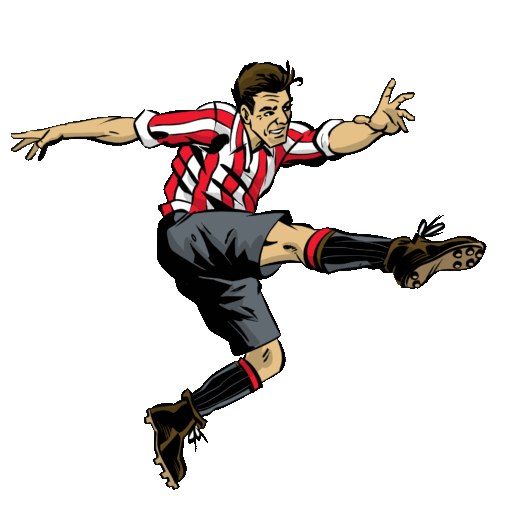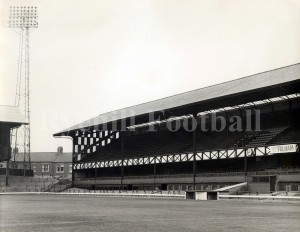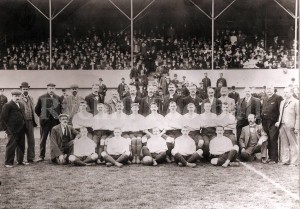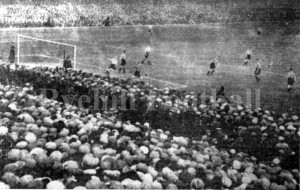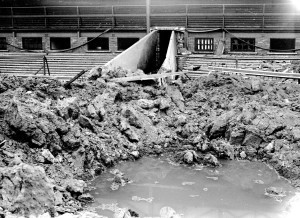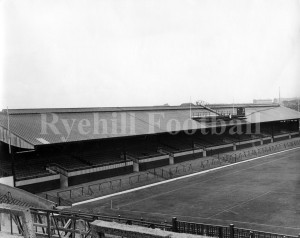Roker Park, Sunderland – 1898 to 1997
RokerPark – The Main Stand
It was the Henderson Brothers, one of whom was the Sunderland AFC Chairman who recognised the need for a bigger ground. They negotiated farmland belonging to a Mr Tennant. The agreement was conditional on Sunderland agreeing that houses could be built on part of the land that became Fulwell Road; also, until the houses were built SAFC had to pay the ground rent on all of the land. The Henderson’s agreed.
Roker Park was built within a year; the wooden stands within 3 months. The Clockstand as it would become known had 32 steps, no seats and crush barriers for safety. There was a slight drop of about 1 foot from the centre to each side for drainage purposes.
At the football club’s annual general meeting at the end of the 1897/98 season it was reported that the Roker Park ground would officially open on 13 August with an “Olympic Games”. Following that the Reserves and First Team played games against each other on 16 August 1898 (2 games).
The financing of the ground had been made possible with the take-up of 1,700 shares in the club.
The Marquis of Londonderry officially opened the ground on 10 September 1898, the then President of Sunderland AFC, turning a gold key in a locked gate that led onto the playing field. He also had a pub named after him “The Londonderry” in the City Centre.
The Roker Park turf was imported from Ireland and was of such quality that it wasn’t relaid until 1927 at a cost of 3,000.
The opponents for The Black Cats on 10 September were Liverpool, the game kicked off at 3.30pm, we wore white tops and a goal by James Leslie, who had been signed from Clyde, gave Sunderland a winning start at their new home. The winning strike came just 6 minutes from time as this match report indicates:
|
1898/99 Football League Division 1 |
|
Sunderland 1 v 0 Liverpool 10 September 1898 |
Opening of Roker Park
The conditions could not have been better for the formal opening of the new enclosure at Roker Park. The weather was delightful and a record crowd for a football match in the North assembled. On top of that Sunderland beat a team that many have already predicted will be league champions when the season ends in April. Surely there could be no happier combination of events.
It will be remembered that the ground had already been open to the public when the Olympic Games were held in August but the formal opening ceremony was performed by the Marquis of Londonderry on the occasion of the 1st home league match of the season. Those who assembled could hardly credit that all the work connected with the construction of this truly magnificent arena had been completed in a little over 4 months.
There are still a few minor details to be attended to but the unfinished work was hidden from view and what the visitor saw was a playing field as level as a billiard table and like a well kept lawn. This was surrounded by tier after tier of freshly painted stands from the top of which hung a succession of gay flags and banners. The impression of those able to judge from personal experience was that there are few grounds in England and Scotland to equal it and certainly none better.
It was not difficult to prophecy that a large crowd would attend for the opening of the ground was the main topic of conversation amongst all classes. As early as 1 o’clock and fully 2½ hours before kick off heavily laden trains deposited their loads at the Central and Monkwearmouth stations and people began to wend their way towards the scene of the ceremony. Tramcars which pass the end of the streets leading from Roker Avenue to the ground were packed and people from Hendon and the East kept the ferryboats that ply between the North and South banks of the Wear busily engaged.
The ceremony at 2-30 was striking. All around the field extending from the white painted railings around the pitch to the uppermost tier of the stand was a seething mass of people. Although actual figures were not available the attendance was estimated at close on 30,000 with everyone in the vast crowd having an unbroken view of the game with not the slightest crushing. To wile away the time the day commenced with Dr. Gunther’s remarkably clever troupe of boy pipers and dancers from Edinburgh who marched from the centre of the town and then played in the middle of the pitch.
The opening ceremony was brief as everyone was impatient for the game to start. Shortly after 3pm Lord Londonderry accompanied by Mr. J.P. Henderson (Chairman), Mr. Jas. Henderson and Mr. G. Childs (Directors) entered the ground and walked across the playing area to the main stand. Here Mr. Henderson handed his Lordship a handsome golden key and asked him to unlock the Iron Gate leading from the dressing rooms to the field to formally open the ground.
Lord Londonderry did so and in the course of a few remarks complimented the Henderson brothers on the excellent work they had done in providing the people of Sunderland with such an excellent enclosure. Sunderland in white shirts took the field first to a great reception. Liverpool quickly followed and a fine looking side they were. Sunderland were forced to make a late change after Dunlop was called away to his brother’s bedside who was seriously burned on Friday.
Bach returned at full back with Ferguson at right half and Wilson on the left. Saxton and Chalmers made up the left wing. Liverpool were at full strength as Wilson won the toss and kicked towards the Roker End with the advantage of a slight breeze. Allan kicked off and Sunderland were the first to show but were quickly sent back. Allan passed to Robertson who dashed up the wing in capital style but Bach stuck with him and eventually won the ball. Sunderland got going again with Morgan prominent but they were not allowed to get within shooting range.
Good work by Robertson and Morgan took the play to the home end where they won a corner off Bach but the flag kick went behind. Wilson sent the home left wing away and Chalmers whipped in a cross that Morgan fired into the net only to be given offside. A long kick by McNeil put Morgan in possession but he was fouled when well placed and the free kick was headed behind. Play moved quickly back to the centre where McAllister conceded a free kick for a foul and Allan put in a real hotshot that Doig saved splendidly.
The ball remained in close proximity to the Sunderland goal as Liverpool attacked determinedly and the home side had several anxious moments until Morgan got the ball away. Nice work from the Liverpool forwards saw them near the home goal once again and this time Bach came to the rescue at a critical moment. Play continued in ding dong fashion and for some minutes was evenly contested. Chalmers worked an opening and got the ball to Morgan who wriggled round Raisbeck only to shoot wide.
Crawford then raced away and centred to Wilson who tested Storrer severely and the custodian was not found wanting. A free kick against W. Goldie in the centre was played in by Bach and Crawford only just failed to get a touch as the ball flashed across the face of the goal. Sunderland were now attacking strongly but the Liverpool defence was excellent and held the tricky home forwards well in check. Allan, Robertson and Walker made occasional breakaways for Liverpool but good work by McNeil and Bach frustrated their efforts.
As the game wore on Sunderland made repeated efforts to break the deadlock with the halfbacks supporting their forwards splendidly but without success. Morgan got the ball to Chalmers who got in a good shot that went just past. At last Liverpool pushed Sunderland back and Doig had to be at his best to keep his charge intact. A tremendous long shot from McAllister had Storrer leaping to tip the ball over the bar in fine style but the corner came to nothing. Splendid work by Bach created a chance for Sunderland but it was missed.
Allan was hurt in a collision and left the field leaving Liverpool with 10 men as halftime approached. They played very pluckily but could make little headway as Sunderland had the better of things up to the interval. They forced 3 successive corners but were still unable to breach the visitor’s goal. The halftime score was 0-0. Allan resumed his place in the 2nd half but was obviously unfit and after struggling pluckily for a few minutes he left the field for good. Liverpool now had the wind in their favour and although handicapped they were not disheartened.
Sunderland were first to attack with Leslie, Crawford and Morgan all putting shots wide. A sharp break by Liverpool was quickly repulsed and they were soon defending again as the home forwards found even better form than in the early stages of the match. Liverpool defended stubbornly with the work of the halfbacks and full backs especially Raisbeck being highly praiseworthy. For fully 10 minutes Sunderland attacked constantly without managing to break down the visitors defence. Eventually Liverpool staged an isolated attack and won a corner but ball went wide of the post.
Nice work by Crawford carried the ball into Liverpool territory and then McNeil went on a solo run from the halfway line to set up a warm attack on Storrer’s goal. It lasted only a minute or two before Bach and McNeil were called upon to clear a Liverpool rush at the other end. Undaunted Morgan of Liverpool sent in a fast long drive that Doig turned round the post. The corner was well placed and Doig saved twice in quick succession. Liverpool remained at the home end for a couple of minutes and free kicks improved their position.
Dunlop sent the 2nd of these straight into the net without another player touching the ball. Sunderland tried again but were unable to score and when Liverpool attacked Robertson missed a glorious chance by putting his shot wide. It was a narrow squeak for Sunderland and the home crowd breathed a sigh of relief. Storrer then tipped a fine shot over the bar but from the flag kick Morgan was penalised for a foul. Dunlop sent another free kick into the Sunderland net untouched and immediately afterwards Liverpool missed another good chance before the home side opened the scoring.
Morgan carried the ball forward nicely and passed to Saxton who whipped it across the goalmouth. Leslie dashed in to get his head to the ball and it flew into the net to put Sunderland ahead 6 minutes from the end. Liverpool claimed that Saxton had been offside but after consulting a linesman the referee awarded the goal. Liverpool made a late effort to save the game but Sunderland clung on to win a very hard game.
Sunderland: Doig, Bach, McNeil, Ferguson, McAllister, Wilson, Crawford, Leslie, Morgan, Chalmers, Saxton
Liverpool: Storrer, Goldie (A), Dunlop, Howell, Raisbeck (A), Goldie (W), Cox, Walker, Allan, Morgan, Robertson.
Referee: Mr. S Fox, Sheffield Attendance: 30,000
Sunderland AFC Team and Officials line up for the opening game at Roker Park
Back Row – left to right – J Peers (Linesman), J Cook (Groundsman), G Young (Linesman), CF De Pledge, WT Doxford (MP), Jas Henderson, Marquis Of Londonderry, JP Henderson (Chairman), C Christton, RT Murray, JJ Bently (League President), S Todd, G Childs, S Wilson
Middle Row – left to right – W Williams (Trainer), W Raisbeck, M Ferguson, R McNeill, JE Doig, P Bach, A McAllister, H Wilson (Captain), J Brown, P Boyle, R Campbell (Secretary)
Front Row – left to right – J Crawford, J Leslie, H Morgan, J Chalmers, A Saxton
By June 1899 the ground was valued by Messrs W & TR Milburn at £7,000 although it is interesting to note that it was reported in 1902 that the club had no formal lease agreement for Roker Park. In 1903 we were barred from playing at Roker Park following crowd disorder in the match against Sheffield Wednesday and had to complete the season playing home games at St James Park.
This wasn’t the club’s first taste of crowd disorder. Since the formation of SAFC visiting clubs and officials had often protested about the partisan nature of the Sunderland crowd and in 1909 a Police Horse was stabbed at the Fulwell End after overcrowding led to fans spilling onto the pitch in a match against Newcastle United.
In 1908 Sunderland AFC bought the land. Fred Taylor or “Mr Sunderland” as we was often referred to, the chairman, along with Sir Theodore Doxford and other businessmen put up the money.
Initially the Main Stand was known as “the President’s Stand”.
In 1912 the Roker End was concreted and elevated following a design by Archibald Leitch, the pre-eminent stadium designer of the day, and through this by 1913 the capacity of the stadium rose to 50,000. Originally the Roker and Fulwell Ends were known as “North” and “South”. Indeed a 1924 plan of Roker Park still refers to them as such.
The 1912 improvement to the Roker End proved of significant value to the team who would train under the enclosure in poor weather.
In 1929 the old wooden grandstand was demolished and replaced by a new “Main Stand” holding 5,875 seats and 14,400 standing places. Archibald Leitch, whose influence can still be seen today at Ibrox Stadium, Glasgow, and many others, designed it. A section of the old lattice work can be seen in the main car park of the Stadium Of Light.
The 1929 improvements had been delayed, due to a lack of finance by 7 years and when they did come about the £25,000 cost nearly bankrupted the football club. At a meeting of the Directors in 1932 they decided to offer the ground for sale to the Sunderland Corporation for £40,000. The purchase was approved by the council but called off at the 11th hour after a change of heart by SAFC. Roker Park still remained a prized possession.
Whilst the official capacity of Roker Park was now 60,000 an incredible 75,118 was present to witness the FA Cup 6th round replay defeat by Derby County in March 1933 (scene from the game pictured above).
The turf was relaid again in 1935 and building work continued at a relentless pace. In 1936 the Clock stand was rebuilt, the turf was relaid again and drains installed under the stands. The 375 feet long Clock Stand structure, able to hold 15,500 standing spectators, was officially opened by Lady Raine, whose husband Sir Walter Raine was the chairman, on 2 September, prior to the game against Derby County, a match won by Sunderland 3 v 2. Lady Raine was presented with a wristlet watch by the designer Archibald Leitch.
By this time Sunderland were announcing record season ticket sales of nearly £39,000.
During the war a policeman was killed just outside the ground; a bomb fell in the middle of the pitch (see above). A similar devise fell in the car park, damaging the old clubhouse on the corner of Roker Baths Road. The Germans of course targeted Sunderland’s industrial workplaces, such as the mines and more importantly the shipyards on the River Wear.
In 1950 the Main Stand was given its “shelf” that was positioned in between the top seats and the paddock. In 1952 Sunderland installed floodlights at Roker Park (the second club to do so after Arsenal) and played there first midweek game under them in a friendly match against Dundee. A series of floodlit matches took place which raised nearly £16,000 in revenue for the club, enough to turn a potential loss into profit.
Due to the wear that the Roker Park pitch was now getting the club agreed to purchase land at Cleadon in 1959, which ultimately became The Charlie Hurley Centre and provided of course the impetus for the current Academy Of Light close to the Cleadon site.
As the 1966 world cup loomed, Sunderland AFC were chosen as a venue ahead of St James Park and received substantial grants and loans from the Football Association to both install permanent seats in the Clockstand and temporary ones in the Fulwell End. The famous Kop was also roofed over and the Roker Park suite was added.
Clock Stand circa 1978
The 1970’s witnessed even more improvements with the floodlights upgraded to European standard lux value. An underground sprinkler system was laid and proceeds from the 1973 FA Cup run (and win) enabled the club to install private boxes in the Main Stand. By the late ‘70’s electronic crowd monitoring systems and roofs were re-sheeted.
The 1980’s brought about a downturn in the clubs fortunes and in truth we began to see a parallel demise with Roker Park. The capacity was reduced considerably with the Roker End suffering the most.
By the 1990’s it was evident that another home was required. Roker Park, hemmed in on all sides gave no room for expansion. With football now moving at an incredible pace, both on and off the field we had to keep up.
Sunderland’s final league game at Roker Park was against Everton on 3 May 1997. The red and whites triumphed 3 v 0. The Northern Intermediate League Cup final was then played on Wednesday 7 May against Middlesbrough. Sunderland again triumphed, this time 2 v 1, with a late Paul Beavers winner.
However perhaps the ultimate irony was in our very last game at Roker Park, on Tuesday 13 May 1997 in which we triumphed 1 v 0 against Liverpool, the same score and the same opposition as the first match at the ground in 1898.
Who writes our script?
Sunderland played a total of 1.812 league games at Roker Park and remained unbeaten in a remarkable 1,445 of them.
Summary
Apart from the Roker End, partly demolished in 1982, the stands and ends remained largely intact from the time of Archibald Leitch’s construction of them, a tribute to his design skills.
Roker Park was the club’s 4rth home on the Monkwearmouth side of the River and all were roughly within a one-mile radius. It became synonymous with, and reeked of, history and passionate support. The heart beat of the ground was of course, The Roker Roar.
